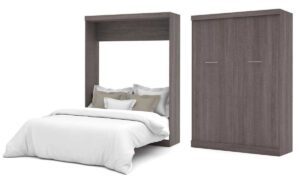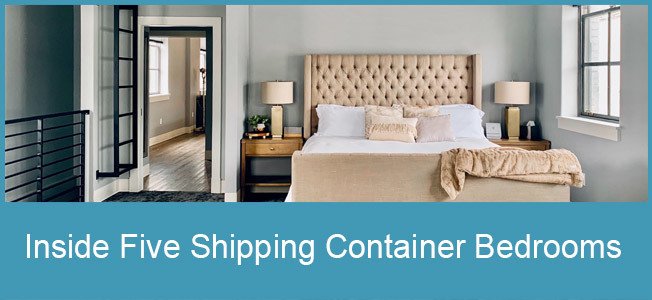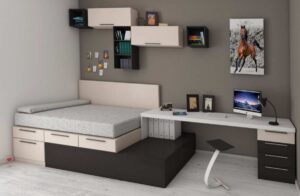Living in a shipping container home is no longer seen as something totally unusual. More and more people are starting to see the benefits of shipping container homes and are figuring out ways to make the most of the living space.
While container homes may have seemed quirky when they first came onto the scene a few decades ago, they are now almost universally recognized as an efficient, economical, and sustainable way of living.
Many container house owners choose a design that’s small in size but this doesn’t mean the interior can’t be comfortable, warm, and homey. Container homes offer a perfect opportunity to create a space that is all your own, stamped with your personal style.
Consider your bedroom design. The purpose is right in the name: a room for a bed. But in many cases, it ends up being quite a bit more.
A place for teenagers to slam the door and listen to music their parents hate. A place for parents to retreat and read in peace. A place for babies to nap. A place for students to do homework.
You may not necessarily have a lot of space to work with inside of a container home bedroom, but you can certainly showcase your personality. Some simple tips go a long way to enhance your ability to meet your specific needs and display your style.
Below are several ideas for your bedroom to help you curate a look and feel that’s all your own.
Start With the End
Think about what you’re trying to achieve with your shipping container bedroom, and work backward from there. More specifically, you should visualize what you’ll actually do in the room. Better yet, think through what you do now in your current bedroom.
As you’re brainstorming the different ways you can and do use your bedroom space, make a list of activities and uses. Examples include: sleeping, storing clothes and personal items, napping, yoga, reading, dressing, studying, listening to music, working, watching TV, folding laundry, making crafts, etc.
Now, think through that list, and decide what could or should be done in other rooms instead. Making that decision is a deeply personal one, and depends on a variety of other factors you’ll have to weigh in your overall container home design, lifestyle, and family structure, and personality.
Asking yourself questions can help guide your decisions. Examples include: Are you introverted or extroverted? Do you live alone or with others? Do you need a small quiet space within the house?
One interesting framework to apply as you think through this is the Danish concept of hygge. The definition is a bit nebulous in English and it represents several ideas including an emotional state, a design aspiration, and general philosophy towards life.
In short, some combination of these descriptors captures the essence of hygge living: coziness, wellness, contentment, happiness, comfort, well-being, balance, harmony, optimism, and simplicity.
If you keep these hygge factors in mind as you refine the requirements for your bedroom, you’re sure to end up with a space that is as intentional as it is functional.
The result of this analysis should be a succinct need statement that explains what you need your bedroom to do. Any activities not explicitly included will be accomplished in another part of the home. This need statement will be your compass as you think through how to design and outfit your bedroom in the best possible way for you.
Use it to conceptualize the specific sizes, shapes, types, and styles of furniture and finishes you’ll use in your bedroom. We’ll refine many of these initial ideas later in this article.
Placement Priorities
In the above section, you thought through what you want to do in your bedroom (beyond just sleeping, which is the baseline). And, you developed at least of rough idea of which pieces of decor you would accomplish it with.
The task before us now is thinking about where to put those things. For most people, the bed is the centerpiece of the bedroom. But if you have several other activities in mind that don’t involve the bed, perhaps the bed isn’t the most important item.
Some container home bedrooms relegate the bed to the edge of the room and are accessible from only one side. Others place the bed in a permanent loft above a desk, closet, or sitting area. Another option is making the bed fold into the wall or retract into the ceiling during in non-sleeping hours.

Beyond the bed, you have to think about other pieces of furniture and even the makeup of the room itself. For instance, and this question may seem controversial: do you want windows in your bedroom? Yes, it will be like a cave, but bears sleep quite well in caves…for months at a time!
Seriously though, if you’re only going to sleep in the bedroom, you may not need windows. In fact, many people use black-out curtains to achieve the same effect as no windows: the absence of light for a good night’s sleep. If you build the bedroom with no windows, you accomplish the same effect with considerable time, cost, and energy savings.
If you do want windows, you’ll have to think about their placement (and size) as it relates to your bed and other possible bedroom items. For instance, a floor to ceiling window that ends up being partially covered by a dresser won’t look very good. But, a midheight window that nicely frames the top of a desk could be fantastic.
Be Future-Focused
You may have thought you were done thinking about your needs for a container home bedroom, but we want to give a subtle reminder that it might also be good to take into account the needs of others in the future.
What we mean by that is, have you considered how the use of your bedroom could change over time? Or how the use of other rooms in the container house might change, and how those changes could affect your bedroom? Considering hypothetical scenarios can help:
- As you age, will you still be comfortable with a bed that’s lofted, pulls down, etc?
- Might you have more or fewer houseguests than you currently do, especially if you’re moving to a new area?
- As your young children grow older, will you still want a place for a crib in the bedroom?
- As your career evolves, might you need a quiet place to work from home occasionally?
- If/when you sell your home, what will other buyers want?
- If you convert your container home into a short term rental, what would visitors like to see?
We can’t give a specific recommendation because everyone’s situation is different. But make sure you’re accounting for the needs of future visitors and even owners of your home as well as your own.
In other words, don’t box yourself in too much. Pun Intended!
Create Wonderful Walls
It’s well known in commercial and residential design that the appearance of a room has a direct effect on occupant happiness. In other words, happy spaces make happy faces! And a great, economical way to affect the entire theme of a space or room is with wall coverings and coatings.
While many of us hesitate to use white when decorating because it might feel too sterile, it actually can work really well in a small shipping container bedroom. It’s often said that for clothes, black is slimming. For rooms, white is just the opposite and helps expand the space.
If you are worried that using white will make your room feel cold or clinical, adding a lot of different textures and patterns in addition to the base white will help.
Another possible wall covering idea is wallpaper. If you’ve tried your hand at DIY home projects in the past, you may have found yourself scraping old wallpaper off the wall and sworn to yourself, ‘Never Again!’
However, designing a small bedroom may be the perfect time to reconsider. Using a bold and stylized wallpaper on one wall of your room creates a focal point. Don’t use it on every wall as it creates a cluttered and claustrophobic look.
Be sure to check out the peel and stick wallpaper options available, too. It’s significantly easier to hang and you can just peel it off when you need a change.
If you pick a wallpaper with a big pattern and bold contrasting colors, your room will be stylish and fun. Pick complementary paint for the opposing walls and bedding with similar colors or tones to tie it all together.
And don’t worry if wallpaper or other fabric wall coverings aren’t your thing. You can still get much of the safe effect using paint! Solid colors, stripes, or even murals are all worth considering. Keep in mind that colored LED strip lights are affordable and allow you to change the color mood of a room almost instantly as well.
For more information on color ideas including some helpful online tools to aid in matching, check out our helpful article on Container Home Interiors.
Accent with Accessories
In a crowded room of businesspeople, one of the first things you might notice are the various fashion accessories everyone is wearing. A nice watch, a classy purse, or even a bold pair of shoes can really make a person stand out from the crowd in a good way.
In the same way, a few accent pieces can add a splash of color and a hint of personality to your container bedroom. Even if you don’t have a lot of excess room to spare, you can still accessorize it to the hilt.
Items like rope lights, funky lamps, throw pillows, unique blankets, and area rugs with accent colors can transform your modest bedroom into the most sought after and comfortable spot in your already comfortable home. Add in some potted plants and favorite photos of your family and travels on the walls to really pull it all together. Don’t forget to use windows curtains as an accent, too.
If sometime in the future you decide to update your bedroom, it’s often easier to change and swap out accessories than it is to change wall coverings and large pieces of furniture. This is an accessible and economical way to make your bedroom stylish and easy to change when you want to. A few small pieces can take you from an industrial to a modern look, or even antique. The choice is yours.
Different materials like linen, cotton, sheer fabrics, unpainted metals, and even live greenery add visual interest and depth while keeping the room light and airy. Alternating patterns and textures with solids and flats allows for consistent color themes while making certain pieces stand out more than others.
Contrasts can be seen in other areas as well, like the textural juxtaposition of cushy bedding with solid container walls. Together, all of these small accents can work to give your bedroom a classic elegance that you might not expect in a small space.
Manage your Possessions
The quote in the above image, from Brad Pitt’s character in the movie Fight Club, is fitting for this section. It’s easy to accumulate a lot of things and spend a lot of time and energy figuring out where to put them. Keeping track of all your stuff can quickly start to fill like a job.
They say that home is where the heart is. It’s telling that the saying makes no mention of possessions. Home is where you can retreat, where you’re free, where you feel inspired and content and a sense of hygge as we mentioned earlier. It shouldn’t just be a building full of your stuff and a source of stress.
If you live in a small shipping container home or are moving into one, you need to at least think about condensing your belongings. This certainly applies to the bedroom specifically as well. What do you need in the short term, what could you store away, and what have you been holding onto from years that you need to let go of?
While you may not be able to have as many personal belongings as you once did, you can still design your bedroom with abundant storage space to keep as much as you can without adding clutter.
Be Vigilant with Volume
Let’s start with a number: 2,700 cubic feet. That’s the internal volume of a 40 ft high cube shipping container before you’ve added any wall/ceiling framing or other finishes. If you’re building a single-container house, that’s your starting number. For multi-container houses, it’s roughly that number multiplied by 2, 3, 4…however many containers you have.
Everything you do after your containers are offloaded works to reduce that 2,700 number and shrink your livable space. It’s not a cause for alarm but simply a call for mindfulness as you think about the interior design.
Every home has a finite amount of space, but you may not be able to visualize the volume you have to work with until months into the project. But with containers, that space is much more apparent and noticeable from Day 1 when the containers arrive on site.
Our advice is to be thoughtful about how you utilize the space you have. When most of us design a bedroom, we tend to plunk things down in a standard way. Bed in the middle, nightstands on each side, dresser along the wall.
In a tiny bedroom, the layout takes a little more thought and ingenuity since your space is not only limited overall but also probably significantly narrower than you’re used to. It helps to think through the ways you could use the volume.
Do you really need a bedside table or nightstand on both sides of the bed, or will one do? Would you have an issue with your bed being a little taller if it gave you additional storage underneath? Is a tabletop lamp next to your bed the best way to get light for reading, or could you have a ceiling-mounted light instead and free up that table’s surface?
Optimizing the bedroom layout by thinking outside of the norms gives you a roomy and comfy place to relax that maximizes the volume you have.
Summary
These ideas for your shipping container bedroom are only the tip of the iceberg for creating a stylish, warm, and welcoming space. Feel free to blend, add, subtract, and use your own style to create a space you love. Designing your space should be fun and the finished product should be a place you enjoy relaxing at the end of the day.









